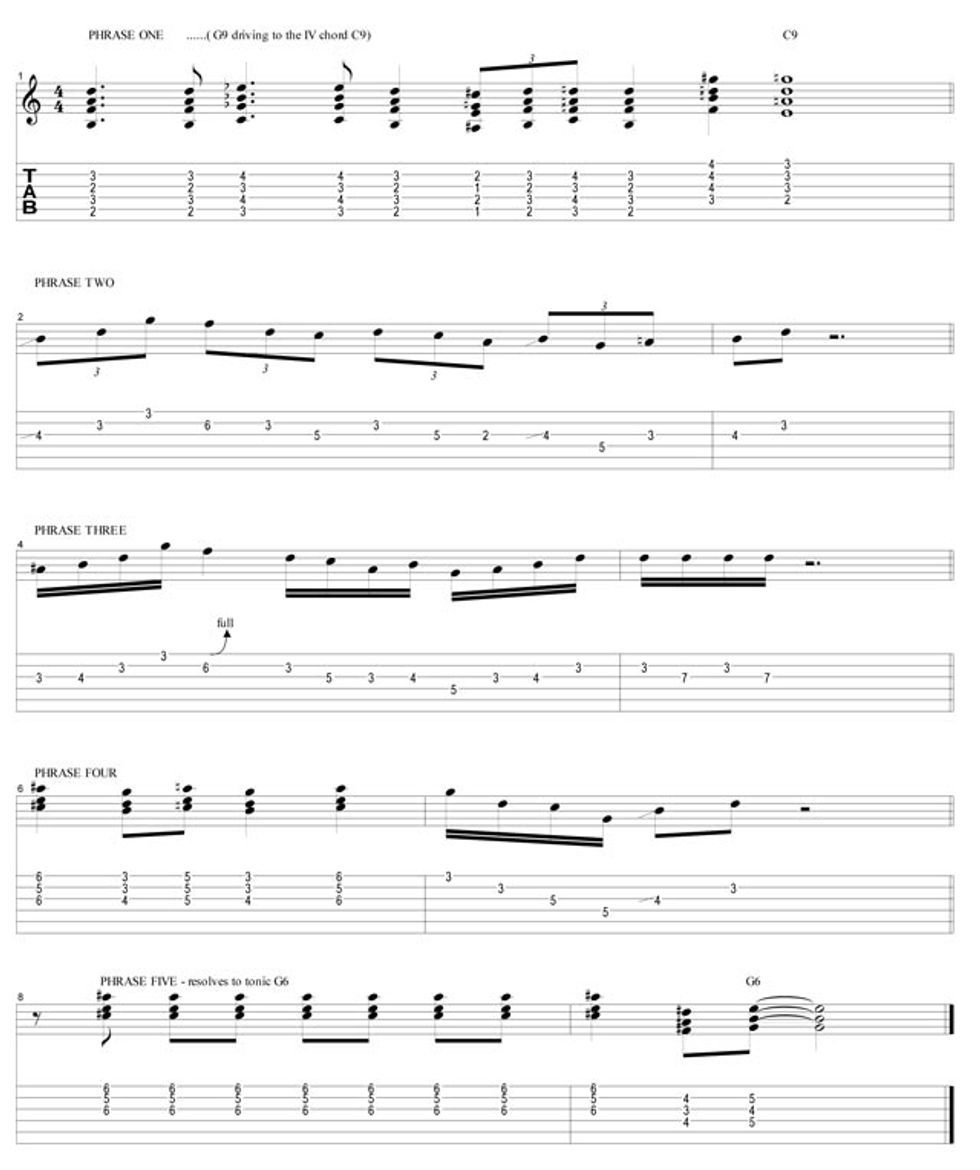There are few figures in our pop music history
that have provided such long-term excitement,
had such far-reaching influence on
artists of many styles, and caused such inspiration
for the electric guitar as has T-Bone
Walker. The list of stars that cite Walker as
their chief influence seems unending. Stevie
Ray Vaughan, Chuck Berry, Jimi Hendrix, B.B.
King, Eric Clapton, Clarence “Gatemouth”
Brown—all regarded T-Bone as one of their
principle guitar heroes and influences. Chuck
Berry commented that everything you see
him do on the stage came from T-Bone.
Laying the foundation for modern urban blues, the electric archtop-playing Walker bridged a gap between blues and jazz guitar styles, and played in a manner that borrowed stylistic cues from both traditions. Although he is credited with moving the acoustic blues style to the electric guitar, his signature style really came from combining that with the influences of both jazz and the forties-style jump-swing bands. Four or five players stand out as the first ones who transferred the blues to electric guitar, but Walker boasted that he beat them all, and claimed to be the first in the late thirties!
It is no wonder his harmonic vocabulary reflects both jazz and blues: in his early days he was mixing with the likes of Charlie Christian, Ma Rainey, Blind Lemon Jefferson, and other Texas performers. In the forties, when he fronted his own bands, his choices for sidemen were the best jazz players he could find. Writers refer to his style as the smoother “California Style” blues. Although he has some of the grit of earlier blues players, as well as that harmonic language, his interest in chordal lines, jazz-style improvised single lines, rhythmic jazz phrasing, and playing with a smooth clean tone are all elements more akin to jazz guitar playing.
His star burned the brightest through the forties. Following that decade, his career was slowed down by growing popular interest in rock ‘n’ roll and declining health (probably related to alcoholism). A devoted European audience and tours to Europe helped keep his career alive in the sixties. Health problems, likely the complications of alcoholism, took their toll when he died of a stroke in 1975. Glamor shots over his career show him with Gibson guitars: ES-250, ES-5 and, in the sixties, the Barney Kessel Regular model.

Come on back next month for T-Bone, Part 2, and even more signature Walker phrases for you to woodshed!
Jim Bastian
A clinician and jazz educator, Jim Bastian is a 10 year veteran of teaching guitar in higher education. Jim holds two masters degrees and has published 6 jazz studies texts, including the best-selling How to Play Chordal Bebop Lines, for Guitar (available from Jamey Aebersold). He actively performs on both guitar and bass on the East Coast.
An avid collector and trader in the vintage market, you can visit Jim’s store at premierguitar.com (dealer: IslandFunhouse).
Laying the foundation for modern urban blues, the electric archtop-playing Walker bridged a gap between blues and jazz guitar styles, and played in a manner that borrowed stylistic cues from both traditions. Although he is credited with moving the acoustic blues style to the electric guitar, his signature style really came from combining that with the influences of both jazz and the forties-style jump-swing bands. Four or five players stand out as the first ones who transferred the blues to electric guitar, but Walker boasted that he beat them all, and claimed to be the first in the late thirties!
It is no wonder his harmonic vocabulary reflects both jazz and blues: in his early days he was mixing with the likes of Charlie Christian, Ma Rainey, Blind Lemon Jefferson, and other Texas performers. In the forties, when he fronted his own bands, his choices for sidemen were the best jazz players he could find. Writers refer to his style as the smoother “California Style” blues. Although he has some of the grit of earlier blues players, as well as that harmonic language, his interest in chordal lines, jazz-style improvised single lines, rhythmic jazz phrasing, and playing with a smooth clean tone are all elements more akin to jazz guitar playing.
His star burned the brightest through the forties. Following that decade, his career was slowed down by growing popular interest in rock ‘n’ roll and declining health (probably related to alcoholism). A devoted European audience and tours to Europe helped keep his career alive in the sixties. Health problems, likely the complications of alcoholism, took their toll when he died of a stroke in 1975. Glamor shots over his career show him with Gibson guitars: ES-250, ES-5 and, in the sixties, the Barney Kessel Regular model.

Come on back next month for T-Bone, Part 2, and even more signature Walker phrases for you to woodshed!
Jim Bastian
A clinician and jazz educator, Jim Bastian is a 10 year veteran of teaching guitar in higher education. Jim holds two masters degrees and has published 6 jazz studies texts, including the best-selling How to Play Chordal Bebop Lines, for Guitar (available from Jamey Aebersold). He actively performs on both guitar and bass on the East Coast.
An avid collector and trader in the vintage market, you can visit Jim’s store at premierguitar.com (dealer: IslandFunhouse).


















